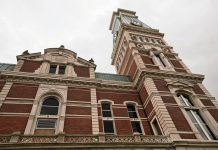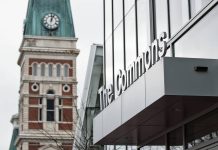A new virtual reality lab at Columbus Signature Academy — New Tech High School allows students to travel far beyond the classroom to explore art, architecture, biology and science.
A new virtual reality lab was developed by Zach Schroeder, a math teacher at the school, who received a $3,000 grant this spring from the Bartholomew Consolidated School Foundation.
Virtual reality systems simulate environments through a headset that will allow students to explore everything from the historical ruins of ancient Greece to the intricacies of a cell within the human body.
The funding helped pay for the equipment for the lab, which includes an HTV Vive headset, controllers and a computer built from scratch by CSA New Tech junior Ivan Lamb. It took Lamb about two weeks to complete his part of the system.
[sc:text-divider text-divider-title=”Story continues below gallery” ]Click here to purchase photos from this gallery
The lab’s technology enhances course content for students, Schroeder said. For example, one application, The Body, allows individuals to look at cells in a virtual environment and analyzing the nucleus, he said.
“The big part of VR (virtual reality) is to get yourself immersed in an environment where you’re seeing everything,” he said.
Schroeder said the immersion would allow students in a health class to learn about the anatomy of a human in a 3-D environment with a body that has manipulative tissue, organs and bones.
The virtual reality lab has 24 applications students may access, including some tied to health and biology, physical education, in addition to math and engineering.
Another application, Google Earth VR, can be used to explore different places around the world, while Google Blocks allows individuals to create 3-D models of different objects, according to Schroeder.
Students in an art or introduction to engineering and design class could visit New York City using the virtual reality technology. That would allow them to view, research and analyze architectural design choices that were made, he added.
CSA New Tech senior Andrew Day is working to create a virtual reality lab space as part of his senior project. It’s expected to be ready by January.
Andrea Behling, who teaches world civilization, said using the technology would be one way to allow her students to experience what ancient Greece or Rome was like. Programs such as Google Earth VR allows students to visit different locations across the globe while still in their classroom.
Virtual reality could also be used to discuss topics such as quadratics in math or gravity in physics to allow students to see how gravity works, Schroeder said. The virtual reality lab could also allow science students exploring protein models to pull at protein strands to see their elasticity and structure, Schroeder said.
Lamb, who eventually hopes to study electrical engineering and computer science in college, said the virtual reality lab also provides an element of fun for students. The controllers are equipped with haptic feedback, meaning that they move when an individual is in the virtual environment depending on what the student is interacting with, Lamb said.
Oopening up the virtual reality lab for teachers and students at other district schools is also being considered.
As more applications are released into the market, those are being reviewed to see how they could be applied at CSA New Tech, according to Schroeder.
[sc:pullout-title pullout-title=”More information” ][sc:pullout-text-begin]
For more details on the virtual reality lab or to learn more about Columbus Signature Academy New Tech’s efforts, contact math teacher Zach Schroeder at [email protected].
[sc:pullout-text-end]




